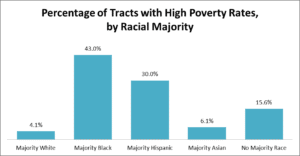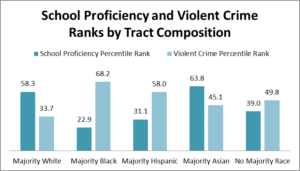Addressing segregation by income, race, and ethnicity
Overview

These differences matter. They not only reinforce existing inequality but also potentially slow overall economic growth by cutting off opportunities for interaction and reducing economic mobility. This brief provides background on how we got here, and what cities, towns, and counties can do to help address segregation.
How we got here
The causes of segregation are multifaceted, but government policies at the federal, state, and local level have contributed. During the Great Migration (1916 – 1970), both private practices and public policies severely constrained the housing options of Black families, steering them into a few, clearly defined Black neighborhoods. Courts stood behind racially restrictive covenants – which bound property owners in white neighborhoods not to sell or rent to a non-white household – and they spread rapidly as a strategy to keep Black people out of white neighborhoods. In 1948, the Supreme Court declared racial covenants legally unenforceable, however the now established racial demarcations continued to hold power long after the decision. The federal government was complicit in this process, reinforcing segregation through maps that the Home Owners Loan Corporation created in the 1930s that arrayed neighborhoods by risk, determined by housing age and density as well as racial composition, through a practice known as “redlining.” Neighborhoods with significant Black populations were literally highlighted in red and residents were deemed less credit-worthy of a long-term, fixed rate mortgage. The Federal Housing Administration continued to use neighborhood racial composition in drafting its underwriting guidelines until 1949, when President Truman directed it to stop pursuing racially discriminatory policies. Neighborhoods of course change over time, but segregation has persisted, as the color lines drawn by these previous policies are not easily erased. They are deeply ingrained in the minds of lenders, realtors, and households. Such implicit or explicit images of neighborhoods shape ongoing discrimination, fuel NIMBY fears, and constrain residential choices of households of all races.
The consequences of segregation
Segregation continues to characterize U.S. cities, towns, and counties. To be sure, Black-white segregation has consistently declined since 1970, and some cities, towns, and counties have seen significant reductions in Black-white segregation. Overall, however, Black-white segregation remained quite high in many cities, towns, and counties in 2010. Further, as Figure 1 shows, we have not seen the same decline for other racial groups. White-LatinxLatinx is a gender-neutral term that is used as an alternative to Latino/a. It refers to people whose origin or ancestry is in Latin America and excludes Spain. Geographic location is what separates this term from Hispanic or Spanish. However, due to terminology differences, the term “Hispanic” may be used on this site whenever describing Census data. segregation has only shown a slight drop, and only in the most recent decade, and white-Asian segregation has been fairly constant since 1980. Nationally, concentrated poverty has been more volatile, rising during the 1970s and 1980s, dropping in the 1990s, and then rising again in the 2000s. Specifically, the percentage of persons with low incomes living in extreme poverty neighborhoods (areas where at least 40% of the population is living in poverty) rose from 12.7 percent to 16.4 percent during the 1990s, dropped to 11.4 percent in 2000, and rose again to 14.1 percent by 2014.
Figure 1

Neighborhoods are separate and unequal
Segregation in U.S. cities has often resulted in large disparities in the resources and services available in the neighborhoods in which different groups live.
Figure 2
Note: High poverty rates defined as poverty rates of 30 percent or more. Majority-Black and majority-Latinx neighborhoods are much more likely to be classified as high poverty (more than 30% living in poverty) and extremely high poverty (more than 40% living in poverty) than are majority-white and majority-Asian neighborhoods. As shown in Figure 2, 4.1 percent of majority-white neighborhoods and 6.1 percent of majority-Asian neighborhoods were classified as high-poverty in 2010, compared to 30 percent of majority-Latinx and 43 percent of majority-Black neighborhoods.
More importantly, there are significant disparities in services and conditions across neighborhoods of different poverty levels and racial make-ups. In terms of schools, research shows that teachers working in schools with more disadvantaged students tend to be less experienced and score lower on a number of performance metrics. Teachers matter. Figure 3 shows that the nearest elementary school to the average low-poverty neighborhood in 2010 ranked at the 64th percentile in terms of school proficiency. In contrast, the nearest elementary school to the average high-poverty neighborhood ranked at only the 24th percentile. Figure 3 also shows large gaps in the performance of schools by racial composition as well. To be sure, some majority-Black and majority-Latinx neighborhoods host schools with experienced teachers and substantial resources, but on average, their residents have access to significantly lower performing schools than residents of majority-white and majority-Asian neighborhoods.
Figure 3
Using data for exposure to violent crime for 91 large cities in 2000, we can identify similar patterns. While the average low-poverty neighborhood had a violent crime rate at the 26th percentile in 2000, the average high-poverty neighborhood had a violent crime rate at the 75th percentile. We see large differences across neighborhoods with different racial compositions as well. In sum, these series of analyses reveal continued large gaps in the neighborhood environments experienced by children of different races and incomes.
Neighborhood resource disparities matter
There is mounting evidence that these neighborhood resources shape children’s outcomes. Researchers consistently find that children from families with low incomes who are given the chance to grow up in lower poverty neighborhoods are more likely to reach their full potential; they are more likely to go to college and enjoy significantly higher earnings as an adult. There is also strong evidence that racial segregation widens racial disparities in individual outcomes because it tends to create a world in which children of different races grow up in neighborhoods with unequal resources. Segregation widens both white-Black and white-Latinx disparities in educational attainment, employment, and income, and even birth weight. Some research also suggests that racial and economic segregation slow overall economic growth by cutting off opportunities for interaction and reducing economic mobility. In other words, segregation may harm entire regions on top of those who are directly affected. A recent report from the Urban Institute finds that Black-white segregation in a metropolitan area is positively associated with homicide rates and negatively associated with the share of the overall population with college degrees. In short, addressing racial and economic segregation and the disparities they have created will not only help to make cities, towns, and counties more inclusive, it may also help fuel their growth. Moreover, the Fair Housing Act requires local governments to affirmatively further the Act’s goals of promoting fair housing and equal opportunity.
How to mitigate neighborhood disparities
Local housing policies, combined with other non-housing policies, can help to mitigate neighborhood disparities and ensure that as many people as possible are able to live in neighborhoods that deliver a rich set of opportunities for advancement. Cities, towns, and counties may wish to consider the following steps to address segregation:
- Track disparities in conditions. The first task is for localities to examine the residential patterns in their region, to understand disparities in access to resources and to track how they are changing over time. Localities would ideally understand how the composition of residents varies across their neighborhoods and in different localities within the larger region, as well as their relative access to basic goods and services. Seattle’s Race and Social Justice Initiative has developed a means of tracking and measuring disparities in the administration of public services ranging from education to development, including the creation of a racial equity toolkit for municipal departments.
- Invest in neighborhoods to ensure that they provide sound services and deliver a rich set of opportunities for residents. Local officials may want to explore new strategies to invest in building opportunities in all communities for all residents. Local housing officials will need to coordinate with officials in other policy domains, including schools, safety, and commercial activity, and smaller localities may need to work cooperatively across their region to equalize opportunity. One instance of such an intersectional program is the Miami Children’s Initiative, which follows the cradle-to-career model utilized by the Harlem Children’s Zone by providing educational, health, job placement, and community building programs to holistically strengthen a neighborhood’s capacities.
Partnering with local community groups is essential. The city of Richmond successfully partnered with local community organizations to develop and implement revitalization plans in a few targeted areas through its Neighborhoods in Bloom Program. Research shows the significant and sustained investments that the program brought to a few neighborhoods led to notable improvements, as measured by property values. Of course, while rising property values indicate that a neighborhood has become more desirable, they also threaten the ability of lower-income renters to remain in place. Affordable housing is thus a key part of successful community development strategies, both to help rejuvenate areas, lock-in affordability, and guard against gentrification.
- Invest in efforts to maintain diversityA description of variety, not equivalent to racial justice or inclusion. in the face of gentrification. In some cities, towns, and counties, growing numbers of higher income and white households have moved into selected lower-income and majority-minority, urban neighborhoods. While these moves offer the promise of integration, they also raise the specter of gentrification and displacement. Local officials can adopt policies that help to preserve the availability of lower-cost housing over the long term, even as nearby property values increase, including tax abatementReduction or elimination of taxes granted to property owners by the government in order to stimulate publicly beneficial activities, such as investment in capital equipment.s for income-eligible residents, project-basinghousing choice voucherOfficially known as “Section 8 Housing Choice Voucher”. It is the largest and most sought after housing program in America. Section 8 HCVs are managed by various public housing agencies (most commonly referred to as housing authorities), which falls under the supervision of HUD. Program participants typically pay 30% of the rent, and the rest is covered by the HCV.s in growing neighborhoods. Localities can also establish new eviction policies and provide legal assistance and other support to residents at risk of losing their homes.
- Support efforts to help families reach resource-richA term to define neighborhoods that offer abundant amenities, such as access to quality schools and public libraries, streets and parks that are free from violence and provide a safe place to play, and fresh and healthy food. neighborhoods. In addition to investing in community development, local governments should also consider taking additional steps to increase opportunities for mobility for families of diverse economic and racial backgrounds.
First, local governments can step up efforts to combat ongoing housing discrimination, including discrimination against households with vouchers. While discrimination has diminished and generally become less overt, it continues in more subtle forms. Local officials might partner with fair housing organizations to spread awareness about discrimination and adopt reforms to combat it. Local officials should consider adopting local laws that prohibit discrimination against households with vouchers. Second, officials can do more to ensure that affordable housing options exist in a wide array of communities, so that residents may have a variety of choices. Although building subsidized housing in resource-rich, high-rent neighborhoods and jurisdictions can be difficult and expensive, policymakers should try to both preserve and expand the affordable stock in such areas. The King County Housing Authority has had some success in acquiring buildings in resource-rich areas and in using project-based vouchers to lock in affordability. Another good example is ARCH, a coalition of high-income suburban cities in King County who work together to develop workforce and low-income housing. A growing number of states are also attempting to incentivize building LIHTC properties in resource-rich neighborhoods. Local officials can support those efforts—for example, by taking care that their allocations of gap financing for LIHTC properties do not work at cross-purposes. Third, local officials can make sure that property owners in resource-rich neighborhoods not only follow anti-discrimination laws in tenant selection but also engage in affirmative marketing to reach a wide array of households. Fourth, local officials can reform their local Housing Choice Voucher programs to enable more families to use vouchers in resource-rich neighborhoods. This may involve recruiting landlords to participate in voucher programs, mobility counseling efforts providing information to voucher holders about a broad array of neighborhoods, and setting Fair Market Rents at the level of the ZIP Code rather than the metropolitan area so homes in a broader set of neighborhoods are affordable to voucher holders. One novel example is the Chicago Regional Housing Choice Initiative. The participating housing authorities in the region have collaborated in an effort to provide information about different neighborhoods, deliver tenant workshops, and offer incentive grants of up to $500 for households choosing to make moves to high-opportunity neighborhoods.

